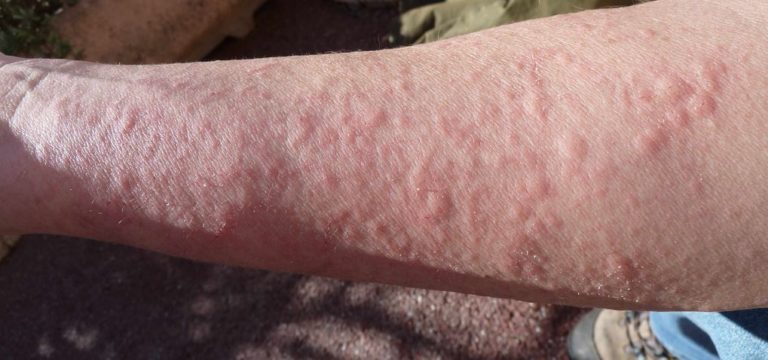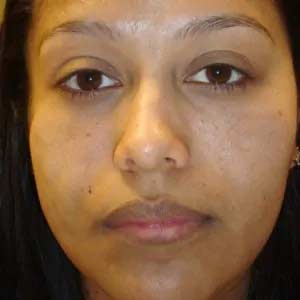Dermatitis Treatment
Conveniently located to serve the areas of Danville, Walnut Creek and Manteca, CA

Rashes/Dermatitis
Also called: Eczema
Are you suffering from a rash that…
- Is severe (raw skin, blisters, oozing, or intense itch).
- Does not clear in a few weeks.
- Comes and goes.
- Is caused by something in your workplace.
This is a common skin disease in children. It is so common that people have given it a few names:
- Eczema (name most people use)
- Dermatitis
- Atopic (a-top-ic) eczema
- Atopic dermatitis
Children often get atopic dermatitis (AD) during their first year of life. If a child gets AD during this time, dry and scaly patches appear on the skin. These patches often appear on the scalp, forehead, and face. These patches are very common on the cheeks.

No matter where it appears, AD is often very itchy. Infants may rub their skin against bedding or carpeting to relieve the itch.
In children of all ages, the itch can be so intense that a child cannot sleep. Scratching can lead to a skin infection.
Because atopic dermatitis can be long lasting, it is important to learn how to take care of the skin. Treatment and good skin care can alleviate much of the discomfort.
How does the Gladstone Clinic treat atopic dermatitis?
Treatment cannot cure AD, but it can control AD. Treatment is important because it can:
- Prevent the AD from getting worse.
- Calm the skin, relieving pain and itch.
- Reduce emotional stress.
- Prevent infections.
- Stop the skin from thickening. Thickened skin often itches all the time — even when the AD is not flaring.
A treatment plan often includes medicine, skin care, and lifestyle changes. Skin care and lifestyle changes can help prevent flare-ups. Many patients receive tips for coping. Doing all of this may seem bothersome but sticking to the plan can make a big difference.
The Gladstone Clinic will create a treatment plan tailored to the patient’s needs. Medicine and other therapies will be prescribed as needed to:
- Control itching.
- Reduce skin inflammation (redness and swelling).
- Clear infection.
- Loosen and remove scaly lesions.
- Reduce new lesions from forming.
Outcome
Studies have found that when AD develops in an infant or young child, the child tends to get better with time. For some children, the condition completely disappears by age 2.
About half (50%) of the children who get AD will have it as an adult. The good news is that the AD often becomes milder with age.
There is no way to know whether the AD will go away or be a lifelong disease. This makes treatment very important. Treatment can stop the AD from getting worse. Treatment also helps to relieve the discomfort.
Tips for Managing Dermatitis
Most children’s eczema does not have a clear cause, such as an allergy, but most eczema will improve with good skin care. These tips from the Gladstone Clinic can reduce the severity and frequency of your child’s flare-ups.
Bathing tips
- Bathe your child in warm — not hot — water.
- Limit your child’s time in the bath to 5 or 10 minutes.
- Use cleanser only when needed and make sure the cleanser is mild and fragrance-free. Do not use bubble bath.
- If your child’s eczema is frequently infected, twice-weekly bleach baths may be beneficial.
- After bathing, gently pat your child’s skin partially dry.
- If your child has medicine that you apply to the skin, apply medicine when your child’s skin is almost dry and use the medicine as directed.
- Apply moisturizer on top of the medicine and to the rest of your child’s skin.
Tips for choosing a moisturizer
- When selecting a moisturizer, consider choosing a thick cream or ointment.
- Some children do better with fragrance-free products, so consider petroleum jelly — an inexpensive, fragrance-free product that works well for many children.
- When selecting a product, “trial and error” sampling of different types may help to identify the best moisturizer for your child.
Tips to ease discomfort
- For best results, apply moisturizer at least twice a day. This prevents dryness and cracking. It also can decrease the need for eczema medications.
- If your child has severe itching and scratching, then wet wrap therapy. This can reduce swelling and lessen the desire to scratch.
- Keep your child’s fingernails short and smooth. This decreases the likelihood that scratching will puncture the skin. Putting cotton gloves on your child’s hands at night may help prevent scratching during sleep.
- Keep temperature and humidity levels comfortable. Avoid situations in which the air is extremely dry, or where your child may sweat and overheat. This is the most common trigger of the itch/scratch cycle.
Clothes-washing tips
- Using a laundry detergent made for sensitive skin may be beneficial. Scented fabric softener or dryer sheets may contribute to irritation.
- Only use the recommended amount of detergent.
- Use enough water for adequate rinsing.
- Buy clothes without tags because tags can rub against the skin, causing irritation.
- Wash your child’s new clothes before wearing. This will remove excess dyes and fabric finishers, which can irritate the skin.
Good skin care is a key part of gaining control of your child’s eczema. If skin care has not been a regular part of your child’s treatment, you should make an appointment for your child to see the Gladstone Clinic
Contact Dermatitis: An Overview
Almost everyone gets this type of eczema at least once. We get contact dermatitis when something that our skin touches causes a rash. Some rashes happen immediately. Most take time to appear.
Allergic contact dermatitis
Some people have an allergic skin reaction. You have had this type of contact dermatitis if you had a rash caused by:
- Poison ivy
- Nickel
- Makeup you applied once or few times
- Jewelry you wore for a long time without a reaction, such as a wedding ring
- Jewelry you wore for only a few hours or days
- Latex gloves
Irritant contact dermatitis
This type is more common. It develops when something irritates the skin. With enough contact, most things will irritate our skin. A person diagnosed with any of the following has irritant contact dermatitis:
- Diaper rash
- Acid burn
- Dry, cracked hands due to lots of contact with water
- Irritated skin around the mouth due to lip licking
When a toxic substance touches our skin, the skin is quickly irritated. You’ve had irritant contact dermatitis if your skin reacted to a toxic substance like:
- Battery acid
- Bleach
- Pepper spray
You can also develop irritant contact dermatitis when you have lots of contact with less irritating substances like:
- Water
- Foods
- Soap
People often develop irritant contact dermatitis at work. Beauticians, nurses, bartenders, and others who spend lots of time with wet hands get this. It often starts with dry, cracked hands. In time, the skin on their hands may begin to sting and burn. The skin becomes very tender. Sometimes, the skin itches and bleeds.
When a rash does not clear within a few weeks, you should see the Gladstone Clinic .When contact dermatitis develops, treatment is important. It can prevent the contact dermatitis from worsening and help your skin heal.
Treatment
Avoid what is causing your rash. If avoiding the cause will be difficult, ask the Gladstone Clinic for help.
For example, if you are allergic to latex but must wear exam gloves, your we can recommend another type of glove that you can wear. If you must work outdoors where poison ivy grows, your we can recommend a protective barrier cream and clothing that can help.
Treat the rash. Once you can avoid the cause, your rash should clear. To relieve your symptoms, we may recommend the following:
- Mild reaction:
- Antihistamine pills, moisturizer, and a corticosteroid that you can apply to your skin. Most patients apply the medicine twice a day for 1 week and once a day for 1 to 2 weeks.
- Oatmeal baths can relieve discomfort.
- Severe reaction:
- If you have a lot of swelling, your face swells, or the rash covers much of your body, you may need a strong medication. We may prescribe prednisone. It is important to take this medication exactly as directed to avoid another flare.
- Wet dressings can help soothe skin that has lots of oozing and crusting.
- If you have an infection, we may prescribe an antibiotic.
- If you avoid what caused the rash, your skin will clear. Most people see clear skin within 1 to 3 weeks.
- Clearing may take longer if poison ivy, poison oak, or poison sumac caused your rash. The first time you have an allergic reaction to one of these plants, the rash may linger for 6 weeks. If you get another rash, your skin should clear within 10 to 21 days.
- Once your skin clears, you must continue to avoid what caused your rash.
- If your rash does not clear, you should tell us. You may need extra help.
Systemic contact dermatitis
Some people develop a rash even when they avoid touching the allergen. A rash can appear when the substance to which you have an allergy gets inside your body. The medical term for this condition is systemic contact dermatitis.
The allergen can get inside your body in different ways. You could:
- Eat food that contains the allergen
- Inhale or inject a medicine that contains the allergen
- Use birth control (IUD or spermicide) that contains the allergen
While rare, some people develop a rash because the fillings in their mouth contain mercury. They could only get rid of the rash when a dentist replaced their fillings with fillings that did not contain mercury.
Trying to find everything that contains the allergen can be a challenge. We may be able to help you create a list of things you need to avoid. The list often varies from region to region.
Outcome for patients with contact dermatitis
By avoiding what caused the rash, most people can avoid flare-ups.
If you work with substances that caused the rash, you can still avoid a rash. We can recommend ways to work and products to use. More than 80% of people diagnosed with occupational dermatitis successfully manage the condition and recover without any problems.
Contact Dermatitis: Tips for Managing
Sometimes you can get rid of a rash yourself. These Gladstone Clinic tips can help you find the cause.
Once you know what’s causing your rash, avoiding it often clears the rash.
To help you find the cause, follow these steps:
Ask yourself the questions on this page (below) that are relevant.
If you answered yes to a question, stop using/wearing what you think caused the rash.
If the rash begins to clear, you may have found the culprit. If the rash worsens or remains for 2 weeks, make an appointment to see the Gladstone Clinic. You’ll need help to get rid of the rash.
Rash beneath jewelry, shoes, or clothing
If a rash develops where jewelry, shoes, gloves or other clothing, a zipper, a buckle, or a fastener touches your skin:
Stop wearing the item for a few days.
If the rash begins to clear when you stop wearing the item, you may have an allergy to a metal, dye, or fabric finisher.
Some people develop an allergy to jewelry that they’ve worn for years. The cause is often nickel, a metal found in many pieces of jewelry. A wedding ring can cause this problem. In fact, this rash is so common that it has a name, wedding-ring dermatitis.
If this happens, ask us for tips to prevent getting a rash from your wedding ring.
Rash on face
It can be a challenge to find the cause of this rash, but you can start by answering the following questions:
- Have you recently tried a new makeup, eye cream, or fragrance? Some people are allergic to ingredients in these products.
- Do you use an eyelash curler or tweezers? These items often contain nickel, which is a common cause of allergic contact dermatitis. Brief direct contact with an eyelash curler or tweezers can cause an allergic skin reaction.
- Do you rub your eyes? If you find yourself rubbing your eyes, try to stop. Indirect contact with an allergen can cause a rash on your face. Even nickel used in a doorknob or keys can end up on your face when you rub your eyes.
- Do you wear nail polish or artificial nails? These products can cause a rash when you touch your face. Even when you don’t develop a rash on your hands, the skin on your face can react.
- Has a fragrance touched your skin? Directly applying a fragrance can cause a rash. You can also get a rash from indirect contact. Touching a a towel or pillow that has a fragrance on it could cause a rash.
Rash on side of face, neck, hairline, or chest
- You can often find the cause of a rash in one of these areas by asking yourself these questions:
- Do you hold your cell phone against your face? A rash that appears on one side of the face may indicate that you have an allergy to nickel or chromium. Some cell phones contain one of these metals. You also could have an allergy to something in the case you use for your cell phone.
- Have you recently switched shampoo or conditioner? If you are allergic to an ingredient in a shampoo or conditioner, a rash can appear where the product runs down your body when you rinse.
- Have you recently used a hair dye or perm solution? These can cause a rash.
Rash after hiking or being in a wooded area
If you were in a wooded area, you may have touched poison ivy, poison oak, or poison sumac without knowing it. Poison ivy is one of the most common causes of allergic contact dermatitis.
The following tips can help:
- Poison ivy: Tips for treating and preventing
Rash from musical instrument
- Metals in musical instruments, such as nickel, cobalt, palladium, silver, and gold, can cause a rash. So too can cane reeds and exotic woods. Stains, glues, and varnishes also cause contact dermatitis.
- We recommend the following to people who get a rash from playing a musical instrument:
- Stop playing the instrument while your skin heals.
- Contact the Gladstone Clinic You may need medication to treat the rash. Patch testing also can be very helpful. This medical test helps to find allergens. It is important to know if you have an allergy to something in the instrument that you play.
- Once the cause is found, the Gladstone Clinic can help you make some changes so that you can play again.
When to see the Gladstone Clinic
You’ll want to make an appointment If you have a rash that:
- Is severe (raw skin, blisters, oozing, or intense itch).
- Does not clear in a few weeks.
- Comes and goes.
- Is caused by something in your workplace.








